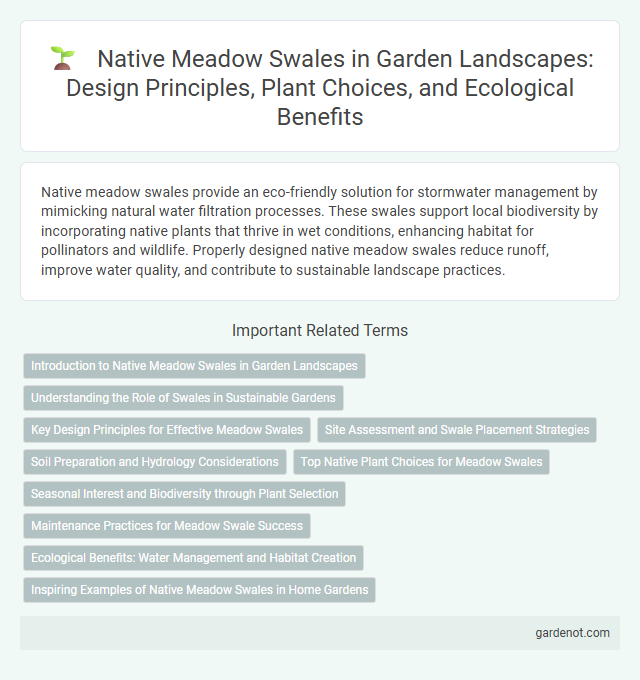Native meadow swales provide an eco-friendly solution for stormwater management by mimicking natural water filtration processes. These swales support local biodiversity by incorporating native plants that thrive in wet conditions, enhancing habitat for pollinators and wildlife. Properly designed native meadow swales reduce runoff, improve water quality, and contribute to sustainable landscape practices.
Introduction to Native Meadow Swales in Garden Landscapes
Native meadow swales transform garden landscapes by efficiently managing stormwater through natural filtration and absorption. These swales, planted with indigenous grasses and wildflowers, enhance biodiversity while reducing soil erosion and runoff. Integrating native meadow swales creates sustainable, visually appealing green infrastructure that supports local ecosystems.
Understanding the Role of Swales in Sustainable Gardens
Native meadow swales function as efficient rainwater management systems that capture and filter runoff, promoting groundwater recharge while reducing soil erosion. These swales support biodiversity by providing habitat for native plants and pollinators, enhancing the ecological balance within sustainable gardens. Integrating native meadow swales improves water quality and conserves resources, making them vital components in eco-friendly landscape design.
Key Design Principles for Effective Meadow Swales
Effective native meadow swales integrate key design principles such as proper grading to ensure controlled water flow and prevent erosion, the use of deep-rooted native plants to enhance soil stability and promote infiltration, and strategic placement to capture runoff from impervious surfaces. Incorporating diverse native species increases ecological resilience, supports local wildlife habitats, and improves water quality by filtering pollutants. Regular maintenance, including seasonal inspections and invasive species management, sustains functionality and preserves the swale's environmental benefits over time.
Site Assessment and Swale Placement Strategies
Conducting a thorough site assessment for a native meadow swale involves analyzing soil type, hydrology, and existing vegetation to determine water infiltration rates and potential pollutant loads. Swale placement strategies prioritize locating the swale downslope of impervious surfaces and within natural drainage pathways to maximize stormwater capture and enhance groundwater recharge. Emphasizing native plant species selection in swales supports local biodiversity while providing effective erosion control and pollutant filtration.
Soil Preparation and Hydrology Considerations
Native meadow swales require well-prepared soil with high organic matter and good permeability to support native grasses and wildflowers. Proper grading ensures water flows slowly through the swale, maximizing infiltration and reducing runoff. Hydrology considerations include maintaining seasonal wetness without prolonged saturation to promote diverse plant communities and effective stormwater management.
Top Native Plant Choices for Meadow Swales
Native meadow swales thrive with top native plant choices such as little bluestem (Schizachyrium scoparium), narrowleaf coneflower (Rudbeckia angustifolia), and switchgrass (Panicum virgatum), all known for their deep roots and drought tolerance. These species enhance water filtration, reduce erosion, and provide essential habitats for pollinators and wildlife. Incorporating diverse native grasses and wildflowers creates resilient meadow swales that support ecological balance and sustainable stormwater management.
Seasonal Interest and Biodiversity through Plant Selection
Native meadow swales enhance seasonal interest by incorporating diverse plant species that bloom sequentially from spring to fall, ensuring continuous visual appeal. Selecting native grasses and wildflowers like purple coneflower, black-eyed Susan, and switchgrass supports local pollinators and wildlife, boosting biodiversity. This strategic plant selection also promotes ecological resilience and soil health within the swale ecosystem.
Maintenance Practices for Meadow Swale Success
Native meadow swale maintenance focuses on regular mowing to control invasive species and promote native plant growth. Seasonal inspections help identify sediment buildup and ensure proper drainage, essential for swale functionality. Applying targeted nutrient management and removing accumulated debris support long-term ecological balance and stormwater filtration efficiency.
Ecological Benefits: Water Management and Habitat Creation
Native meadow swales enhance water management by naturally filtering stormwater, reducing runoff, and promoting groundwater recharge. These swales create diverse habitats for pollinators, birds, and amphibians, supporting local biodiversity. Integrating native vegetation in swales strengthens ecosystem resilience and improves water quality.
Inspiring Examples of Native Meadow Swales in Home Gardens
Native meadow swales transform home gardens by enhancing water management and promoting biodiversity through drought-tolerant native grasses and wildflowers. Examples like the Pacific Northwest native swale featuring blue wildrye and camas lily demonstrate effective rainwater capture and habitat creation for pollinators. Homeowners benefit from reduced irrigation needs and vibrant ecosystems by incorporating these ecologically designed landscape elements.
Native meadow swale Infographic

 gardenot.com
gardenot.com